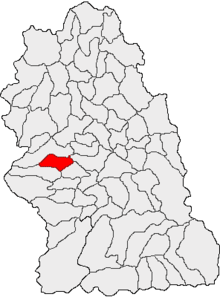Read
|
Lelese Lelsdorf Lelesz |
||||
|
||||
| Basic data | ||||
|---|---|---|---|---|
| State : |
|
|||
| Historical region : | Transylvania | |||
| Circle : | Hunedoara | |||
| Coordinates : | 45 ° 44 ' N , 22 ° 42' E | |||
| Time zone : | EET ( UTC +2) | |||
| Height : | 790 m | |||
| Area : | 75.81 km² | |||
| Residents : | 406 (October 20, 2011) | |||
| Population density : | 5 inhabitants per km² | |||
| Postal code : | 337295 | |||
| Telephone code : | (+40) 02 54 | |||
| License plate : | HD | |||
| Structure and administration (as of 2016) | ||||
| Community type : | local community | |||
| Structure : | Lelese, Cerișor , Runcu Mare , Sohodol | |||
| Mayor : | Ciprian-Gheorghe Achim ( PSD ) | |||
| Postal address : | Str. Principală, no. 20 loc. Read, jud. Hunedoara, RO-337295 |
|||
| Website : | ||||
| Others | ||||
| City Festival : | “Măsuratul oilor” ( sheep counting ), in May. | |||
Lelese ( German Lelsdorf , Hungarian Lelesz ) is a municipality in the Hunedoara district in Transylvania , Romania .
Geographical location
The municipality of Lelese is located in the southwest of the Transylvanian Basin, east of the Poiana-Ruscă Mountains , in the historical region of Hunyad County ( Eisenmarkt County ). On the county road ( Drum județean ) DJ 687F, the place is about 31 kilometers west of the city of Hunedoara ( iron market ); the district capital Deva ( Diemrich ) is located about 48 kilometers northeast of Lelese.
history
The place Lelese was first mentioned in a document in 1319.
About a blast furnace built in 1806–1810, rebuilt in 1851, in the present-day area of the village of Govăjdia ( scythe hammer ) of the municipality of Ghelari ( ⊙ ) and which at the time of its creation was the largest blast furnace on the territory of present-day Romania, was opened in February 2011 claims by the authorities of the municipality of Lelese that this belonged to Lelese between 1952 and 1968 according to old maps and when the administrative area was redesigned. The blast furnace is a listed building.
Talc , limestone and dolomite were mined in the municipality . Funding was largely discontinued. The main occupations of the population are cattle breeding , agriculture and forestry .
population
In 1850 there were 1485 inhabitants on the territory of the municipality. 1471 of them were Romanians , 11 Roma , two Magyars and one Transylvanian Saxon . The highest population of the municipality (1894) - that of the Romanians (1851) and that of the Magyars (11) - was reached in 1900. The highest number of Germans (9) in 1890 and that of Roma (12) was counted in 1930. In addition, in 1992 a resident of Runcu Mare (Hungarian Nagyrunk ) referred to himself as a Slovak. The population has been declining since 1900. In 2002 there were 511 people living in the Lelese municipality, 508 of whom were Romanians and three were Hungarians.
Web links
Individual evidence
- ↑ 2011 census in Romania at citypopulation.de
- ^ Dictionary of the localities in Transylvania
- ↑ Heinz Heltmann, Gustav Servatius (Ed.): Travel Guide Siebenbürgen. Kraft, Würzburg 1993, ISBN 3-8083-2019-2 .
- ↑ Web presentation of the blast furnace ( Memento of the original from September 3, 2014 in the Internet Archive ) Info: The archive link was inserted automatically and has not yet been checked. Please check the original and archive link according to the instructions and then remove this notice. (Romanian)
- ↑ Ciprian Iancu: The blast furnace from Govăjdia is controversial in court , February 9, 2011 on Replica, accessed on July 11, 2011 (Romanian)
- ↑ List of historical monuments of the Romanian Ministry of Culture, updated 2010 (PDF; 7.10 MB)
- ^ Censuses 1850-2002 for Hunyad County, p. 109 (Hungarian; PDF; 1.1 MB)


